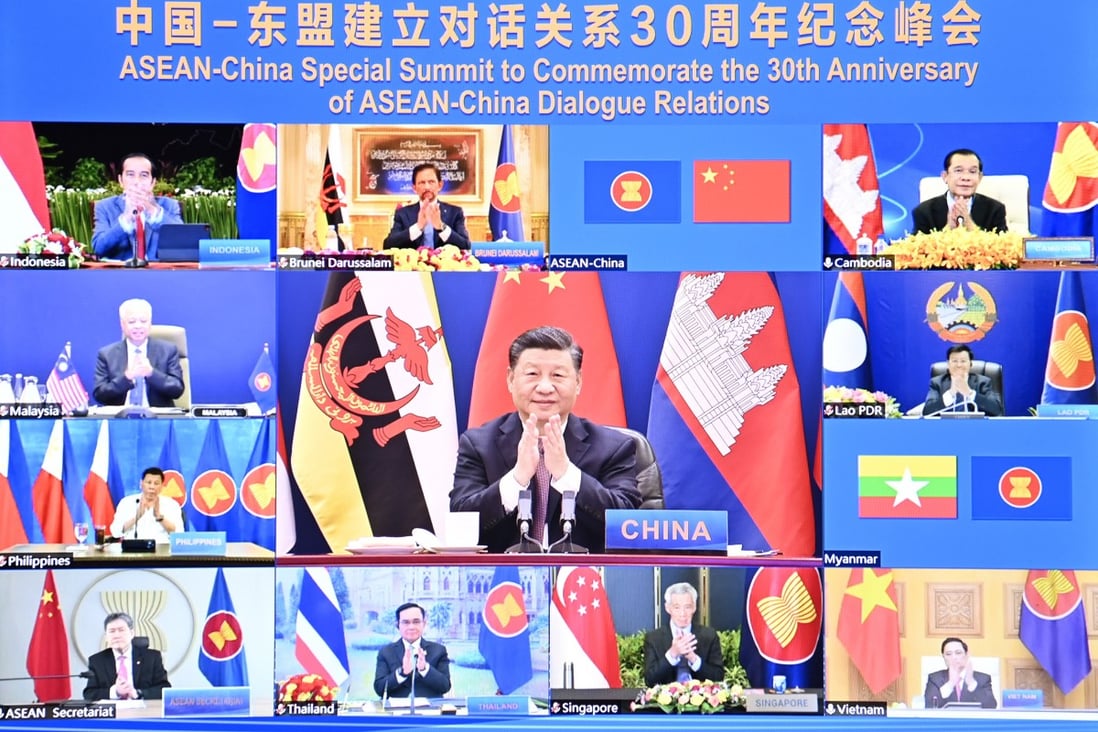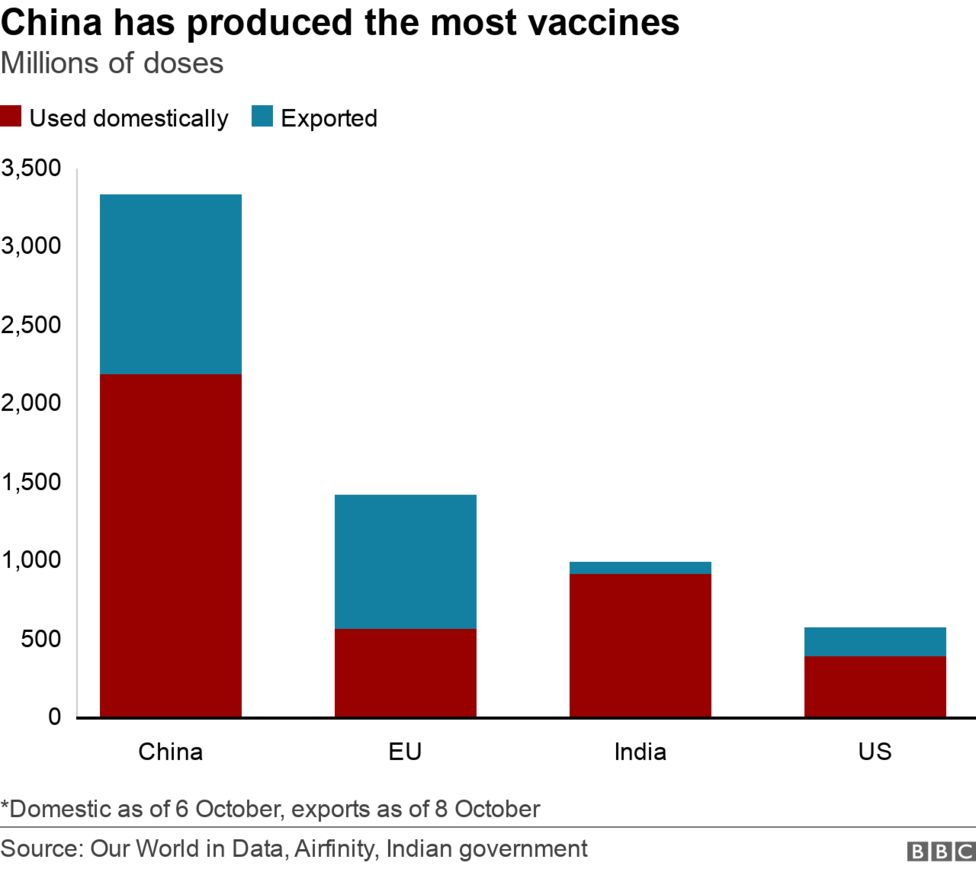Can the US ever match China’s concrete economic offers to Asean?

Chinese President Xi Jinping chairs an Asean-China summit.
When Chinese President Xi Jinping met Southeast Asian leaders at a virtual summit on Monday, he cited a Chinese proverb to suggest that China was, is, and will always be a good neighbour, friend and partner to the region.
“Distance tests a horse’s strength, and time reveals a person’s integrity”, Xi said, before launching into the various forms of assistance that Beijing would provide to help Southeast Asia tackle and recover from the pandemic, such as contributing to a pandemic fund and providing additional vaccines.
During a similar meeting with leaders of the Association of Southeast Asian Nations (Asean) late last month, US President Joe Biden said that America’s relationship with the region was “essential in maintaining a free and open Indo-Pacific” to, among others, “uphold freedom of the seas and commerce”.
In a statement later released by the White House, Washington announced a raft of similar initiatives, but valued at almost 15 times less than what their Chinese counterparts offered.
In the battle for influence in the region between the US and China, Beijing has always won hands down in delivering concrete and more substantive economic goods, while Washington’s approach has often been described as being centred on security.
This lopsided approach needed to be addressed, said Hoo Chiew-Ping, a senior lecturer in strategic studies and international relations at the National University of Malaysia, “if the Biden administration wishes to show commitment to the region”, adding that additional economic aid from the US would “be highly appreciated by regional countries”.
And while Southeast Asian countries welcomed China’s offers of aid, these would not reduce their mistrust of China as they did not address challenges between Beijing and the region, said Hanh Nguyen, a non-resident WSD Handa fellow at the Honolulu-based Pacific Forum,
“[These challenges] include the South China Sea disputes and broader concerns over the negative impact of China’s rise on the region,” Hanh said, referring to China’s territorial disputes with Vietnam, the Philippines, Malaysia and Brunei over the resource-rich South China Sea.
Thitinan Pongsudhirak, a political-science professor at Thailand’s Chulalongkorn University, said this week’s summit was aimed at shoring up China’s influence and role within Asean, given the formation of the Aukus security alliance between Australia, the UK and the US and recent friction between Beijing and the Philippines.
In September, the US, Australia and the United Kingdom set up the trilateral security pact to counter China, while last week, the Chinese coastguard fired water cannons to block a Filipino resupply mission to a military outpost in the South China Sea.
US: limited aid, nebulous trade
Of the US$102 million announced by Biden, US$40 million will go to an initiative to help address the Covid-19 pandemic and strengthen Asean’s ability to prevent, detect and respond to future outbreaks of infectious diseases.
Another US$20.5 million will finance climate mitigation, and up to US$20 million will go on supporting cooperation in trade and innovation. Another US$17.5 million is earmarked for education projects, and US$4 million to promote gender equality.
During Gina Raimondo’s visit to the region last week, the US Secretary of Commerce pitched a nebulous new “economic framework” comprising the US and its allies that would involve ad hoc sectoral cooperation rather than a full-suite trade pact.
Noting that last week’s discussions were “really, very much preliminary” with further developments expected only next year, Raimondo said it was too early to say exactly which countries would be included.
Acknowledging that the Biden administration had been much too slow in announcing trade frameworks it will use to engage the region, Murray Hiebert, a Southeast Asia expert at Washington’s Centre for Strategic and International Studies said this had deeply disappointed and frustrated Asean countries.
“Many countries in the Indo-Pacific are waiting for Washington to step up its economic engagement to match its more robust security cooperation,” Hiebert said.
In an attempt to counter China, the US has increasingly turned its attention to the region through visits by top officials, stepped up military presence especially in the South China Sea, and strengthened military alliances such as restoring the Visiting Forces Agreement, which allows a large American military presence in the Philippines.
China's economic largesse
Washington’s modest aid contributions and the lack of a multilateral trade strategy stands in sharp contrast to what China has to offer.
These include US$1.5 billion in development assistance to help Southeast Asian countries with pandemic control and economic recovery for the next three years, and a promise to import US$150 billion worth of Asean agricultural products for the next five years.
Beijing will also provide US$5 million to an Asean pandemic fund, and 150 million Covid-19 vaccine doses, which according to Aaron Jed Rabena, a research fellow at the Manila-based think tank Asia-Pacific Pathways to Progress, is China’s way of maximising its vaccine diplomacy – Beijing’s ongoing efforts which began last year when China vaccine companies signed deals with mainly lower and middle income countries to supply them with Chinese-made vaccines.
“Covid-19 remains the most immediate concern to Asean countries,” Rabena said, referring to how the pandemic had taken a toll on many Southeast Asian countries where economic activities have declined, shops and factories closed and visitor numbers plunged.
Hiebert said that most Southeast Asian countries were much more enthusiastic about the more efficacious US vaccines than Sinovac and Sinopharm, the Chinese-made equivalents.
“In the midst of Southeast Asian countries facing serious Covid outbreaks and resulting economic downturns, China has continued to harass Malaysia, the Philippines, Indonesia and Vietnam in their exclusive economic zones (EEZs) in the South China Sea,” Hiebert said.
Apart from firing water cannons on Filipino vessels last week, Chinese survey ships have in recent months – at times flanked by Chinese coastguard vessels – been spotted lingering in the North Natuna Sea, which is part of Indonesia’s EEZ.
Security-wise, Beijing has also agreed to sign the protocol to the SEANWFZ Treaty, as early as possible, despite saying for the past two decades that it would not do so.
Signed by Asean members in 1995, the Treaty of Southeast Asia Nuclear Weapon-Free Zone (SEANWFZ) is a commitment to keep the region free of nuclear and other weapons of mass destruction.
However, Hiebert said much would depend on when China would eventually sign the protocol and what amendments it would insist upon.
“China’s overture may be in response to Aukus under which the US plans to provide Australia with nuclear submarines,” Hiebert noted.
Can the US play catch up?
While Beijing’s approach to providing economic incentives contrasted with Washington’s emphasis on security, Him Raksmey, a research fellow at the Cambodian Institute for Cooperation and Peace, said that support from both was “crucial for the region”.
However, this lopsided approach on the part of the US might lead to China wielding greater influence over Asean, as the region’s deepening engagement with Beijing meant that China would “surely be able to shape their policy preferences such as the extent of their alignment with the US” and the way disputes were handled with China, said Pathways to Progress’ Rabena.
Kei Koga, an assistant professor at Singapore’s Nanyang Technological University, said that since the US was still in the process of formulating its Indo-Pacific strategy, including its relationship with Asean, it would take more time for the US to come up with specific policies towards the region.
While it would be difficult for the US to match China’s economic presence, Pacific Forum’s Hanh said Washington should rely on sectors such as financial services where it has strengths, and where American companies are perceived as more transparent.
But with Biden’s focus on domestic politics, Hahn said that even though “Southeast Asia has re-emerged as a priority for the US, it is [still] not a top priority.”

 www.scmp.com
www.scmp.com
- In the US-China battle for influence in Southeast Asia, Beijing has always won hands down in delivering the economic goods, while Washington is centred on security
- If the Biden administration is serious about its commitment, the US needs to start putting its money where its mouth is, experts say

Chinese President Xi Jinping chairs an Asean-China summit.
When Chinese President Xi Jinping met Southeast Asian leaders at a virtual summit on Monday, he cited a Chinese proverb to suggest that China was, is, and will always be a good neighbour, friend and partner to the region.
“Distance tests a horse’s strength, and time reveals a person’s integrity”, Xi said, before launching into the various forms of assistance that Beijing would provide to help Southeast Asia tackle and recover from the pandemic, such as contributing to a pandemic fund and providing additional vaccines.
During a similar meeting with leaders of the Association of Southeast Asian Nations (Asean) late last month, US President Joe Biden said that America’s relationship with the region was “essential in maintaining a free and open Indo-Pacific” to, among others, “uphold freedom of the seas and commerce”.
In a statement later released by the White House, Washington announced a raft of similar initiatives, but valued at almost 15 times less than what their Chinese counterparts offered.
In the battle for influence in the region between the US and China, Beijing has always won hands down in delivering concrete and more substantive economic goods, while Washington’s approach has often been described as being centred on security.
This lopsided approach needed to be addressed, said Hoo Chiew-Ping, a senior lecturer in strategic studies and international relations at the National University of Malaysia, “if the Biden administration wishes to show commitment to the region”, adding that additional economic aid from the US would “be highly appreciated by regional countries”.
And while Southeast Asian countries welcomed China’s offers of aid, these would not reduce their mistrust of China as they did not address challenges between Beijing and the region, said Hanh Nguyen, a non-resident WSD Handa fellow at the Honolulu-based Pacific Forum,
“[These challenges] include the South China Sea disputes and broader concerns over the negative impact of China’s rise on the region,” Hanh said, referring to China’s territorial disputes with Vietnam, the Philippines, Malaysia and Brunei over the resource-rich South China Sea.
Thitinan Pongsudhirak, a political-science professor at Thailand’s Chulalongkorn University, said this week’s summit was aimed at shoring up China’s influence and role within Asean, given the formation of the Aukus security alliance between Australia, the UK and the US and recent friction between Beijing and the Philippines.
In September, the US, Australia and the United Kingdom set up the trilateral security pact to counter China, while last week, the Chinese coastguard fired water cannons to block a Filipino resupply mission to a military outpost in the South China Sea.
US: limited aid, nebulous trade
Of the US$102 million announced by Biden, US$40 million will go to an initiative to help address the Covid-19 pandemic and strengthen Asean’s ability to prevent, detect and respond to future outbreaks of infectious diseases.
Another US$20.5 million will finance climate mitigation, and up to US$20 million will go on supporting cooperation in trade and innovation. Another US$17.5 million is earmarked for education projects, and US$4 million to promote gender equality.
During Gina Raimondo’s visit to the region last week, the US Secretary of Commerce pitched a nebulous new “economic framework” comprising the US and its allies that would involve ad hoc sectoral cooperation rather than a full-suite trade pact.
Noting that last week’s discussions were “really, very much preliminary” with further developments expected only next year, Raimondo said it was too early to say exactly which countries would be included.
Acknowledging that the Biden administration had been much too slow in announcing trade frameworks it will use to engage the region, Murray Hiebert, a Southeast Asia expert at Washington’s Centre for Strategic and International Studies said this had deeply disappointed and frustrated Asean countries.
“Many countries in the Indo-Pacific are waiting for Washington to step up its economic engagement to match its more robust security cooperation,” Hiebert said.
In an attempt to counter China, the US has increasingly turned its attention to the region through visits by top officials, stepped up military presence especially in the South China Sea, and strengthened military alliances such as restoring the Visiting Forces Agreement, which allows a large American military presence in the Philippines.
China's economic largesse
Washington’s modest aid contributions and the lack of a multilateral trade strategy stands in sharp contrast to what China has to offer.
These include US$1.5 billion in development assistance to help Southeast Asian countries with pandemic control and economic recovery for the next three years, and a promise to import US$150 billion worth of Asean agricultural products for the next five years.
Beijing will also provide US$5 million to an Asean pandemic fund, and 150 million Covid-19 vaccine doses, which according to Aaron Jed Rabena, a research fellow at the Manila-based think tank Asia-Pacific Pathways to Progress, is China’s way of maximising its vaccine diplomacy – Beijing’s ongoing efforts which began last year when China vaccine companies signed deals with mainly lower and middle income countries to supply them with Chinese-made vaccines.
“Covid-19 remains the most immediate concern to Asean countries,” Rabena said, referring to how the pandemic had taken a toll on many Southeast Asian countries where economic activities have declined, shops and factories closed and visitor numbers plunged.
Hiebert said that most Southeast Asian countries were much more enthusiastic about the more efficacious US vaccines than Sinovac and Sinopharm, the Chinese-made equivalents.
“In the midst of Southeast Asian countries facing serious Covid outbreaks and resulting economic downturns, China has continued to harass Malaysia, the Philippines, Indonesia and Vietnam in their exclusive economic zones (EEZs) in the South China Sea,” Hiebert said.
Apart from firing water cannons on Filipino vessels last week, Chinese survey ships have in recent months – at times flanked by Chinese coastguard vessels – been spotted lingering in the North Natuna Sea, which is part of Indonesia’s EEZ.
Security-wise, Beijing has also agreed to sign the protocol to the SEANWFZ Treaty, as early as possible, despite saying for the past two decades that it would not do so.
Signed by Asean members in 1995, the Treaty of Southeast Asia Nuclear Weapon-Free Zone (SEANWFZ) is a commitment to keep the region free of nuclear and other weapons of mass destruction.
However, Hiebert said much would depend on when China would eventually sign the protocol and what amendments it would insist upon.
“China’s overture may be in response to Aukus under which the US plans to provide Australia with nuclear submarines,” Hiebert noted.
Can the US play catch up?
While Beijing’s approach to providing economic incentives contrasted with Washington’s emphasis on security, Him Raksmey, a research fellow at the Cambodian Institute for Cooperation and Peace, said that support from both was “crucial for the region”.
However, this lopsided approach on the part of the US might lead to China wielding greater influence over Asean, as the region’s deepening engagement with Beijing meant that China would “surely be able to shape their policy preferences such as the extent of their alignment with the US” and the way disputes were handled with China, said Pathways to Progress’ Rabena.
Kei Koga, an assistant professor at Singapore’s Nanyang Technological University, said that since the US was still in the process of formulating its Indo-Pacific strategy, including its relationship with Asean, it would take more time for the US to come up with specific policies towards the region.
While it would be difficult for the US to match China’s economic presence, Pacific Forum’s Hanh said Washington should rely on sectors such as financial services where it has strengths, and where American companies are perceived as more transparent.
But with Biden’s focus on domestic politics, Hahn said that even though “Southeast Asia has re-emerged as a priority for the US, it is [still] not a top priority.”

Can the US ever match China’s concrete economic offers to Asean?
‘Many countries in the Indo-Pacific are waiting for Washington to step up its economic engagement to match its more robust security cooperation.’







